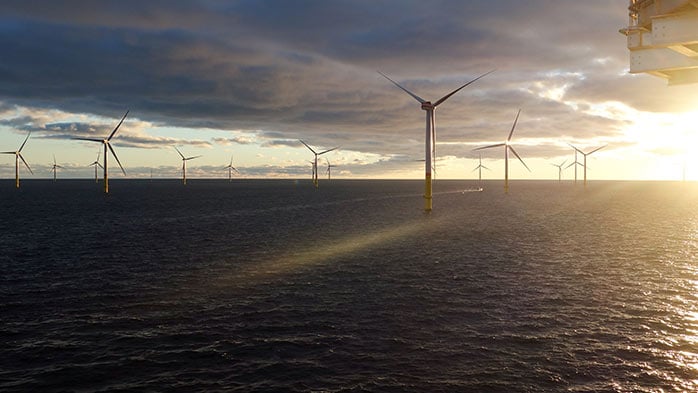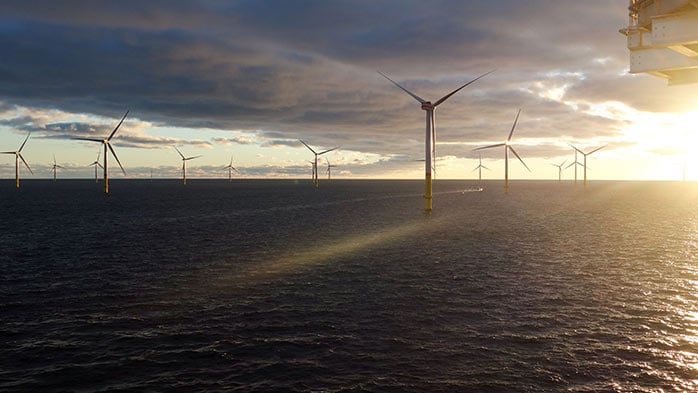Wholesale power prices are more naturally defined by fossil-based power costs, but renewables create new cost categories that are neither traditional wholesale price nor network cost. This has implications for future prices that will need to be paid by large energy users.
Wholesale power prices are easily defined on a fossil-based grid
The wholesale electricity price is a key indicator of the underlying cost of power and, as such, the price paid by different users is, in most countries, linked to that price, after added costs for transmission and distribution (T&D) plus other levies and taxes. For example, here we can see how users with different power usages are charged relative to the wholesale power price in Italy.
For large energy users, the cost of power is typically closer to the underlying wholesale price. Eurostat only provides data for users up to >150,000 MWh/y, but a steel mill, for example, will use much more power than that. The red data points above are an estimate of power costs to a very large energy user – such as a steel mill – and more generally reflect an industrial user that is able to tap directly into the transmission network and so incurs fewer costs to access power. These prices remain relatively static compared to the underlying wholesale power price, particularly in the mid-range.
So, the wholesale price is an important determinant of ultimate power costs, certainly to large users, but as grids decarbonise, the current definition of ‘wholesale price’ is beginning to break down. This is beginning to cause confusion about what might be the final power price to consumers under a grid decarbonisation scenario and will have implications for the viability of current operations as well as project development.
Across Europe, power prices are typically set based on the cost of marginal generation that, for many countries, is natural gas-based – the chart below shows the relationship between natural gas-based power costs and the wholesale power price in recent years, again, in Italy, as an example.
Also shown is a view of wholesale prices out to 2050, assuming a continuation of the same pricing mechanism and with gas-based power retaining a core role in power generation. This estimate considers our forecast of natural gas and carbon prices out to 2050 and shows wholesale prices are expected to rise in real terms, primarily driven by higher carbon prices.
The cost of generating power from natural gas (n.b. or coal for that matter) is easy to define with very clear boundaries, and when we do so, there is a clear relationship with reported wholesale prices, as shown. However, as grid decarbonisation progresses with the move to greater levels of renewable energy (RE), it becomes less easy to define what exactly constitutes the wholesale price and this relationship breaks down.
The definition of ‘wholesale price’ is less clear with renewables
The chart below shows a modelled cost structure of both a fossil-based and RE-based grid. In this modelling, we have assumed the grid is made up only of either fossil-based power (n.b. gas-based in this example) or largely RE, but where RE is used, the costs associated with firming variable output are also included. ~6% fossil power on the grid is retained in the latter case as this is a lower cost option and is also aligned with the UK Low Carbon Power 2030 plan (i.e. the cost of removing the last ~5–6% of fossil power is increasingly expensive).
Current prices of natural gas and CO2 have been used to reflect current fossil-based power costs, whereas RE and associated costs are closer to those expected in 2030 (i.e. some cost reduction from current levels has been assumed) but these are given in real 2024 terms. This analysis is in US dollars.
Here we can see that, with 100% fossil-based power, the wholesale price of power is expected to be ~$105 /MWh, close to today’s value, whereas a RE-heavy grid has total costs of firm power closer to ~$146 /MWh, so ~40% higher. However, looking only at the underlying cost of the RE that provides the required number of electrons to the grid (i.e. Core RE fixed and Core RE variable), so ignoring oversizing, storage etc., costs only amount to ~$60 /MWh, a ~40% reduction relative to gas-based power.
This is important as, if the wholesale power price is set, or defined, based strictly on the underlying costs of generating power, which is broadly the case today, then we would expect it to fall as RE is rolled out. Indeed, under the EU ‘Green Industrial Deal’, which includes the ‘Affordable Energy Action Plan’, the EU Commission estimates a shift to RE could “cut [wholesale] electricity prices in Europe by up to 40%”, which matches the above estimates. However, this approach fails to take account of the added costs associated with RE needed to render output firm and which make up more than half of the total costs of providing firm power.
As an aside, the natural gas-based power costs shown in Figure 2 imply that, sometime between 2035–2040, firmed RE-based power production will be cost competitive with natural gas-based power, but this requires a carbon price of ~€130–140 /tCO2 (real 2024).
Using battery storage only for firming is high-cost
As explained, the modelled decarbonised electricity grid is based on fossil power retaining a 5–6% generation role, an optimised solar:wind mix to minimise output variability, overbuilding of RE to minimise supply deficits, demand flexibility and battery storage at 50% of daily grid output. Still, a question typically asked is, “Why not just use batteries to smooth the supply of RE as batteries are really cheap now?” To demonstrate why this is not the best cost solution (n.b. and it may not be the best technological solution either), below we show the cost of grid power if storage – at the same cost as battery storage – is used in place of both overbuilding and flexible fossil power.
In this modelling, we assume an optimum solar:wind mix still, a small amount (i.e. 10%) of RE overbuild, up to 30% demand flexibility as before, fossil energy at ~6% of generation and 0% of generation in two scenarios, with storage absorbing the residual variability.
Using battery storage (n.b. or any storage but at the cost of battery storage) rather than a combination of RE overbuild and some fossil-based power, alongside demand management, is a very costly means of smoothing variable RE output. In these examples, battery energy storage system (BESS) capex. costs (i.e. full turnkey costs) would have to fall to ~$47 /kWh and ~$22 /kWh of storage capacity for the full system. Based on reported project costs, current full turnkey BESS costs outside China are above ~$350 /kWh, so ~90% cost reductions would be required.
Further, such a system would require batteries that are both shorter duration (i.e. <6 hours) to accommodate intraday variability and longer duration (i.e. >1 day) for longer period variability. The costs used are typical of LFP BESS systems, but these are not technologically suitable for long durations and different technologies (e.g. vanadium flow), that are typically more expensive than LFP systems, would need to be applied. Pumped hydro will also play a role.
Wholesale power price – a cost measure ripe for change
We believe, today, many commentators assume the wholesale power price will retain a broadly similar definition in the future, which automatically implies that power prices will fall as RE is rolled out. However, this approach ignores new costs – that will need to be borne by consumers in some way – that arise as a result.
Our view is that the current definition of ‘wholesale price’ will not be adequate for a decarbonised grid and will need to be redefined to include some, or all, of the additional cost items. How this is dealt with by regulators will have major implications for the electricity price change seen by those that currently own, or are thinking of investing in, energy intensive operations.
If you are thinking about your exposure to electricity price changes under grid decarbonisation, or of an investment that is materially dependent on power price, contact us and we would be happy to talk through our thinking.

















